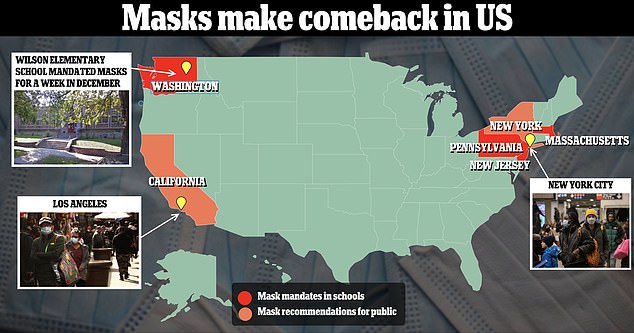Do YOU think face masks are justified? Vote here and tell us why…
>
As US schools bring back mask mandates, do YOU think face coverings are justified? Vote here and tell us why…
<!–
<!–
<!–<!–
<!–
<!–
<!–
Face masks are quietly returning to daily life as concerns about a new variant of Covid grow and flu and RSV continue to spread.
Hundreds of thousands of students across the US will be forced to wear face coverings in class as schools begin to reopen today as controversial mandates return.
Despite Covid infection rates stagnating for months, elementary and secondary schools in New Jersey, Massachusetts and Pennsylvania have made masks a condition of admission for students returning from vacation.
And officials in New York City, Los Angeles and Washington state have begun recommending its use in indoor public spaces, but have stopped short of implementing the mandates.
But there is conflicting evidence on whether face masks really reduce infection rates on a large scale.
And mounting research shows that the mandates stunted children’s social development and education.

Despite covid infection rates stagnating for months, elementary and secondary schools in New Jersey, Massachusetts and Pennsylvania have made face coverings a condition of entry for students returning from vacation. A week-long mask mandate was implemented at a school in Washington last month and several states have issued mask recommendations to the public.
Paradoxically, masks, lockdowns and other covid restrictions are thought to have deprived children of vital immunity to other seasonal bugs like the flu and RSV, which may be why those bugs are causing such rates. discharges of infection and hospitalization now.
Now there are growing signs that other pandemic policies are starting to make a comeback.
Last week, the US government announced that all passengers from China, which is experiencing a major outbreak, would be screened upon entry, despite there being no proof that the policy works either.
There are about 400,000 Covid cases a week in the US now compared to 4 million around this time last year, during the Omicron outbreak.
Weekly cases have been stable since late summer, a trend attributed to high levels of immunity in the population through vaccination and waves of infections.
But 22 states were still reporting “very high” flu activity in the week before Christmas, up from 26 the week before. Six states recorded the highest transmission levels, up from eight in early December.
The flu season in the United States came unusually early, although cases of influenza and respiratory syncytial virus (RSV) were reported for the second week in a row just before Christmas, meaning that the ‘triple epidemic’ in the United States could soon reach its peak. finish.
RSV is also a few weeks ahead of the flu crisis. Cases peaked in November, but rates are still very high. Both have led to hospitals, particularly children’s hospitals, being overwhelmed.
The Strep A bacterial infection is also increasing among children and has killed at least two in Colorado. The Centers for Disease Control and Prevention (CDC) issued an urgent notice warning message about the infection before Christmas, notifying doctors and public health authorities of the situation.
